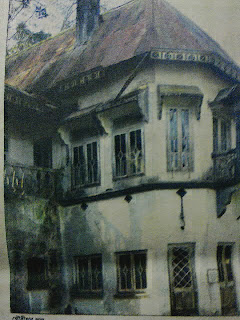houses where he used to live, still there, but neglected.
'Gouripur Lodge' is the name of a bungalow where the poet loved to
live at Kalimpong, near Darjeeling. The lodge surrounded by various
trees and within calm atmosphere beside hills. Tagore first came here
on 25 April, 1938 and zamindar Brojendra Kishore Roy Chowdhury of
Gouripur arranged for the boarding & lodging of the poet here. The
poet was craving
for a calm and peaceful place to live in for a few days. So, he liked
the place. After a few days, the enthusiastic local people
delightfully arranged the 80th birthday celebration of Tagore here.
The famous writer of 'Na Hanyate' Moitreyee Debi came from Mongpu and
insisted the poet to write a new poem. And the poet wrote 'Janmadin' -
the famous poem. A memorable event occurred on that day - the poet
recited this poem over telephone and All India Radio Calcutta
broadcasted it. By this way, inception of telecommunication between
Kalimpong and Kolkata occurred. After two years, on 21 April, 1940 the
poet arrived here again and this time he planted two camphor trees by
his own hands at one corner of the garden. He used to water those
little trees both in the morning and evening. Now the two trees have
hues of big trees. The poet came here for the last time on 20
September, 1940 to recover his health, but within 7 days he had to
return back Kolkata with serious conditions. Before leaving the lodge,
the poet wrote a poem, in my delight, sound and colour altogether - do
you know, Kalimpong?
At present, this lodge of Kalimpong is remained like an abandoned
house due to negligence and lack
of care. There are no boundary walls, the garden lost its pride, no
sign of furniture used by the poet, the windows and doors dilapidated.
Roots of baniyan trees emerged from the walls. The outhouse which once
used as kitchen, now a ruined room. The half bust statue of Tagore in
the ground floor now missing. Ironically, a name plate is there
outside the house stating, Kabiguru Rabindranath Thakur once resided
in this house. No one comes here. The house remains in utter darkness
at night due to want of electricity. No one knows how many days the
lodge will be there with this hues.
Mongpu always attracted Tagore. It is a small village 52 Kms away from
New Jalpaiguri, on the lap of mountain. During the stay at Kalimpong,
the poet came here several times and stayed at the house of Moitreyee
Debi. As an honourable guest, the poet stayed here happily and had
written many poems. Now the house is 'Rabindra Bhavan' - National
Museum. But not in a position to visit gladly due to lack of proper
management. No electricity is here, the prayer room needs renovation,
no printed books for visitors although a statue of Tagore by renowned
sculptor Chintamoni Kar is there. The priceless manuscripts and
photographs of the poet now attacked by fungus. The colours, brushes
for paintings used by the poet remained there haphazardly. And all
these are within reach of visitors. In fact, a total picture of
negligence and lack of proper care one can view inside this house.
If proper steps for the maintenance would not be taken, we may soon
lose the memoir of one of the important and remarkable part of life of
our beloved poet Rabindranath Tagore.
Pic1&2 - Gouripur lodge, Kalimpong.-
Pic3 - Kitchen of Gouripur lodge.
Pic4 - Notice board about the poet.
Pic5 - Upasana Griha of Tagore.
Pic6 - water colour used at Kalimpong by Rabindranath.
Pic7 - colours used by Tagore.
Pic8- Camphor trees planted by Rabindranath.
A. B.








Comments
Regards
HotelTravelia - Provides best hotel rates
www.hoteltravelia.com
Email: contactus@hoteltravelia.com